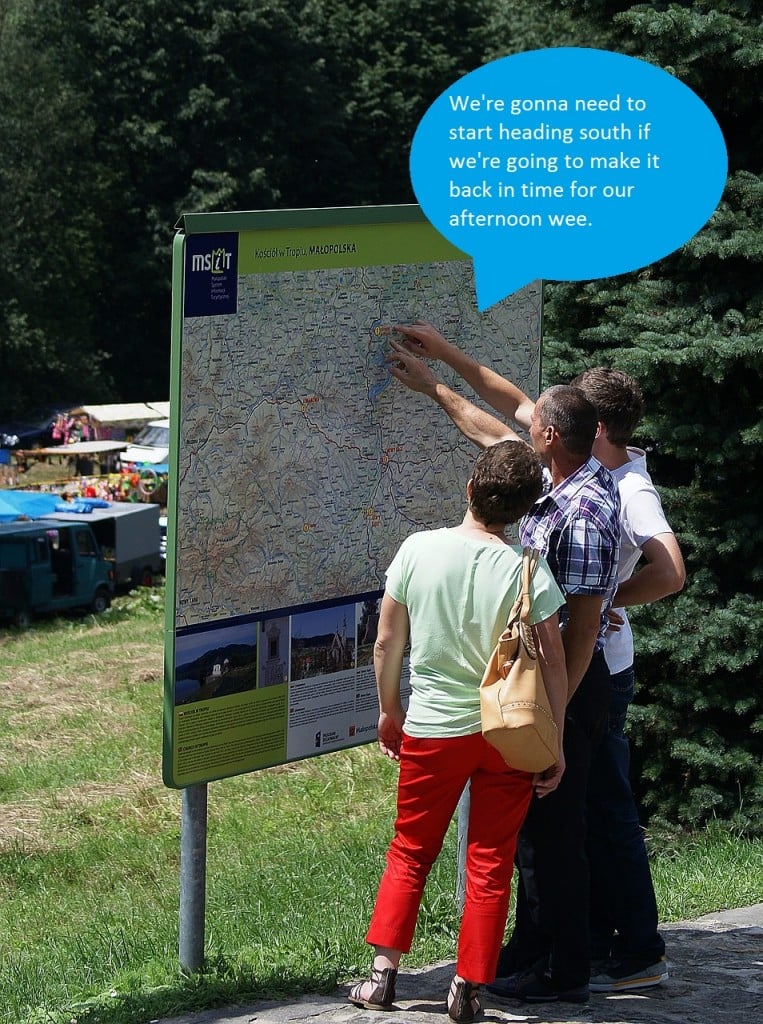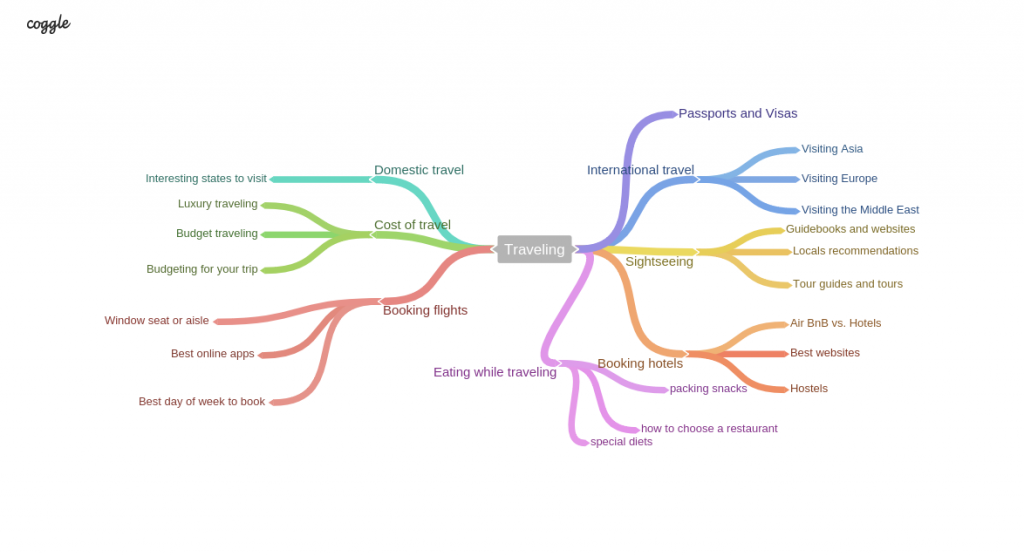I’m a traveler. During my journeys, I have met myriad travelers, each with different ways of traveling.
One of the most interesting differences I’ve noticed has been the various ways in which travelers prepare for a trip. Interestingly, it mirrors the different prewriting strategies writers use to prepare for an essay.
On one end of the spectrum, there is what I call “The Hippie.” This traveler doesn’t plan anything. He shows up at the bus station and asks for the next bus out, regardless of where it is heading.
There are many people who do the same thing when writing an essay, jumping in without any plan.
On the other end of the spectrum, there is what I affectionately call “My Mom.” Now, when “My Mom” travels, everything is planned downed to the minute. This traveler knows where she will eat, sleep, and pee before the wheels have even begun rolling in the direction of her destination.
Similarly, there are writers who plan every dotted “i” and crossed “t,” to use an old expression, before actually sitting down to write their essays.
Obviously, these travelers/writers are quite different in regards to their planning habits. Just as there are many ways to prepare for a trip, there are many strategies for preparing for your next essay that fall somewhere between the above extremes.
Let’s take a look at 6 prewriting strategies to get your essay rolling.
What Is Prewriting and Why Do I Need to Do It?
First, what is prewriting exactly? In this handout from Duke, prewriting is defined as “a blanket term for a wide range of techniques to start thinking about your paper before you begin the formal process of writing a draft.”
Pretty standard, self-explanatory stuff there. Prewriting is all the work you do on your essay before actually writing it. Essentially, the prewriting process begins the moment you read your assignment.
All of the thought and work you put into your subject–including your research, your outlining, and your notes on napkins–are part of the prewriting process. This process takes time, but it is worthwhile.
Although traveling like “The Hippie” can be exciting and freeing, any veteran traveler will tell you it isn’t the best way to travel. If you travel without any plan whatsoever, you will end up looking back at the end of your trip and realizing you missed out on something exciting that was nearby, because you didn’t even know it was there.
Similarly, writing like “The Hippie” is less than ideal. Without any prewriting, there’s a good chance you will look back at your finished draft and realize you missed something important. Think of it like traveling without a map. You might get to your destination eventually, but you’re probably going to take an unconventional and inefficient path.
Just jumping right in can be overwhelming, too. The idea with prewriting is to get your essay rolling in the right direction in a manageable way. If done correctly, it can give you the chance to get your ideas straight and think about what style, strategy, and form your essay will follow. This takes a lot of stress off of you when it comes time to actually sit down to write.

Now, I’m not arguing for writing like “My Mom” either, but a small amount of structured prewriting time can go a long way towards making your essay more well-rounded and complete.
Our goal will be to identify some healthy and productive prewriting strategies that can help to get your essay rolling in the right direction, toward a finished product that you can be proud of.
Note that just as there are varied types of travelers, all writers are different too. The prewriting strategy that works best for you might not work so well for another writer. Identifying the best prewriting strategy for your learning and writing styles takes time and practice.
Below is a list of some of the most common approaches.
Prewriting Strategy 1: Brainstorming or Listing
There is a good chance that your brain is swimming with thoughts, ideas, questions, and answers related to your topic. Brainstorming gives you the chance to extract as many of these ideas as possible.
Take a few blank pieces of paper. At the top of one, write down your focus. This could be the writing prompt, a sentence, an idea, or simply a word related to your essay.
Once you have this in front of you, start jotting down all of the words and phrases that pop into your head. Don’t write in complete sentences. Don’t worry about grammar or spelling. Keep going for ten minutes.
When you are finished, take a look at your list and see which ideas stand out to you. Which ones grab your attention? Which ones are worth focusing and expanding upon?
The KU Writing Center suggests that you group your items in a way that makes sense to you and then label each group. This gives you points of interest to focus on in your paper. Keep these points of interest handy, because we can use them with the next strategy.
Prewriting Strategy 2: Freewriting
Freewriting takes the general idea behind brainstorming a step further. Instead of just writing words or phrases, with freewriting, you will write full sentences.
Again, take a blank piece of paper and set a timer for 10 minutes. Start by writing down a sentence related to your paper, and then DON’T STOP. Whatever comes to mind related to your subject, write it down, disregarding anything related to grammar.
The idea is to keep your pen moving, writing sentences nonstop to see what comes out. If you get stuck, you can rewrite the previous sentence. Just keep writing. The point isn’t to draft writing that will be turned in to your professor. Instead, you’re hoping to find a few sentences buried in your freewriting that can help focus your ideas.
Now, remember those points of interest that you came up with while brainstorming? You can use each one as the first sentence in separate freewriting activities, giving yourself a chance to expand them into sentences.
Prewriting Strategy 3: Mapping or Clustering
Are you a visual learner? Can you better understand a subject when you can see it? Then, why not draw a picture of your essay?
“Mapping” or “Clustering” has long been one of the best prewriting strategies for making a paper more manageable. And, now that you have lots of keywords and phrases from the last two strategies, you are ready to give it a try.
The idea is to take the most important word or phrase from you essay and write it in the middle of your paper with a circle around it. Then, think of the key points related to that subject. Write each of these in circles that surround the central topic and connect to it by lines.
Check out this clustering example from Santa Barbara City College to see what I mean.
As you can see, the more you think about each connected point, the more your map will grow. Eventually, you will run out of related ideas. You can then take a step back and look at your web of ideas.
Check out this online mind mapping tool, if you prefer to work from your computer. Oh, and here is another cool free online mind mapping tool. Mind mapping, in general, can be a great tool for finding the main ideas of your paper, which can then be developed in the next strategy.
Prewriting Strategy 4: Journalist’s Questions
You now have a better grasp of the main ideas in your paper. However, you need to make sure that you haven’t missed something along the way.
Journalists ask certain questions every time they write a story:
- Who?
- What?
- Where?
- When?
- Why?
- How?
You can ask yourself these same questions in relation to your essay topic in order to make sure you have covered all bases and also to help you focus your topic.
Depending on the topic of your essay, you might have a lot to say about Who? and very little to say about What? However, in your next essay, it may very well be the opposite. Don’t worry. Let the topic guide your answers to the questions, which will help you to hone in on the most important aspects you will need to cover.
Prewriting Strategy 5: Outlining
Once, you feel like you have a strong grasp on the aspects of your essay that you will focus on, and you’ve used some great prewriting strategies to explore them, you can move on to forming the skeleton of your essay, known as an outline.
The outline will help you to organize your information in a structure that will work for your paper. This is the moment in the process when you start thinking about your thesis statement, so you can organize an introduction, body, and conclusion to your essay that works best for your main idea.
We’ve already created several great resources related to outlines on this blog, including posts on 5-paragraph essay outlines, argumentative essay outlines, and expository essay outlines.
Even if your essay doesn’t fall neatly into one of these categories, the information provided will help you to get your essay outline started.
Prewriting Strategy 6: Critical Reading
The last prewriting strategy I want to talk about is critical reading. Once a preliminary thesis has been developed in your outline, it is important to keep critical reading in mind when researching your subject.
Don’t mindlessly read and take notes–highlighting everything in your source is going to make things more difficult later in the writing process.
Instead, focus on your thesis and the areas of your sources that relate to it. York University describes critical reading as talking directly to the author in your mind. Let that author guide your thoughts and notes while reading about your subject.
Final Thoughts on Prewriting Strategies
While taking a look at the above list of prewriting strategies, did any particular one jump out at you? If so, give it a try. If it doesn’t work out the way you hoped, amend it to fit your needs or try another strategy. Eventually you will find a prewriting routine that fits your needs and leads to a beautifully well-rounded essay.
An interesting way to help with this process is to understand your personality type, as it can affect your writing. Check out this link from Villanova. You can take a personality test and then see specific writing characteristics related to your personality, as well as tips to keep in mind when writing. This information can help when formulating the best prewriting strategy for you.
However, remember to be flexible. What works for one essay might not work for another. Keep experimenting with strategies. And, don’t forget to do some “postwriting” as well. And by that I mean, make sure you have your essay edited!





